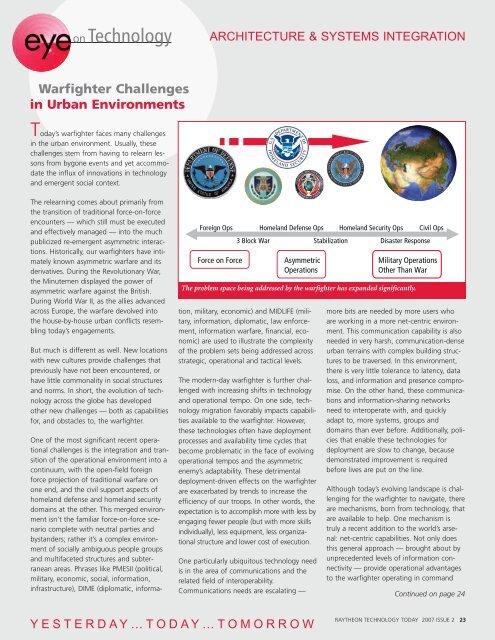2007 Issue 2 - Raytheon
2007 Issue 2 - Raytheon
2007 Issue 2 - Raytheon
Create successful ePaper yourself
Turn your PDF publications into a flip-book with our unique Google optimized e-Paper software.
onTechnology<br />
Warfighter Challenges<br />
in Urban Environments<br />
Today’s warfighter faces many challenges<br />
in the urban environment. Usually, these<br />
challenges stem from having to relearn lessons<br />
from bygone events and yet accommodate<br />
the influx of innovations in technology<br />
and emergent social context.<br />
The relearning comes about primarily from<br />
the transition of traditional force-on-force<br />
encounters — which still must be executed<br />
and effectively managed — into the much<br />
publicized re-emergent asymmetric interactions.<br />
Historically, our warfighters have intimately<br />
known asymmetric warfare and its<br />
derivatives. During the Revolutionary War,<br />
the Minutemen displayed the power of<br />
asymmetric warfare against the British.<br />
During World War II, as the allies advanced<br />
across Europe, the warfare devolved into<br />
the house-by-house urban conflicts resembling<br />
today’s engagements.<br />
But much is different as well. New locations<br />
with new cultures provide challenges that<br />
previously have not been encountered, or<br />
have little commonality in social structures<br />
and norms. In short, the evolution of technology<br />
across the globe has developed<br />
other new challenges — both as capabilities<br />
for, and obstacles to, the warfighter.<br />
One of the most significant recent operational<br />
challenges is the integration and transition<br />
of the operational environment into a<br />
continuum, with the open-field foreign<br />
force projection of traditional warfare on<br />
one end, and the civil support aspects of<br />
homeland defense and homeland security<br />
domains at the other. This merged environment<br />
isn’t the familiar force-on-force scenario<br />
complete with neutral parties and<br />
bystanders; rather it’s a complex environment<br />
of socially ambiguous people groups<br />
and multifaceted structures and subterranean<br />
areas. Phrases like PMESII (political,<br />
military, economic, social, information,<br />
infrastructure), DIME (diplomatic, informa-<br />
Y E S T E R D A Y … T O D A Y … T O M O R R O W<br />
ARCHITECTURE & SYSTEMS INTEGRATION<br />
Foreign Ops Homeland Defense Ops Homeland Security Ops Civil Ops<br />
3 Block War Stabilization Disaster Response<br />
Force on Force Asymmetric<br />
Operations<br />
tion, military, economic) and MIDLIFE (military,<br />
information, diplomatic, law enforcement,<br />
information warfare, financial, economic)<br />
are used to illustrate the complexity<br />
of the problem sets being addressed across<br />
strategic, operational and tactical levels.<br />
The modern-day warfighter is further challenged<br />
with increasing shifts in technology<br />
and operational tempo. On one side, technology<br />
migration favorably impacts capabilities<br />
available to the warfighter. However,<br />
these technologies often have deployment<br />
processes and availability time cycles that<br />
become problematic in the face of evolving<br />
operational tempos and the asymmetric<br />
enemy’s adaptability. These detrimental<br />
deployment-driven effects on the warfighter<br />
are exacerbated by trends to increase the<br />
efficiency of our troops. In other words, the<br />
expectation is to accomplish more with less by<br />
engaging fewer people (but with more skills<br />
individually), less equipment, less organizational<br />
structure and lower cost of execution.<br />
One particularly ubiquitous technology need<br />
is in the area of communications and the<br />
related field of interoperability.<br />
Communications needs are escalating —<br />
Military Operations<br />
Other Than War<br />
The problem space being addressed by the warfighter has expanded significantly.<br />
more bits are needed by more users who<br />
are working in a more net-centric environment.<br />
This communication capability is also<br />
needed in very harsh, communication-dense<br />
urban terrains with complex building structures<br />
to be traversed. In this environment,<br />
there is very little tolerance to latency, data<br />
loss, and information and presence compromise.<br />
On the other hand, these communications<br />
and information-sharing networks<br />
need to interoperate with, and quickly<br />
adapt to, more systems, groups and<br />
domains than ever before. Additionally, policies<br />
that enable these technologies for<br />
deployment are slow to change, because<br />
demonstrated improvement is required<br />
before lives are put on the line.<br />
Although today’s evolving landscape is challenging<br />
for the warfighter to navigate, there<br />
are mechanisms, born from technology, that<br />
are available to help. One mechanism is<br />
truly a recent addition to the world’s arsenal:<br />
net-centric capabilities. Not only does<br />
this general approach — brought about by<br />
unprecedented levels of information connectivity<br />
— provide operational advantages<br />
to the warfighter operating in command<br />
Continued on page 24<br />
RAYTHEON TECHNOLOGY TODAY <strong>2007</strong> ISSUE 2 23

















